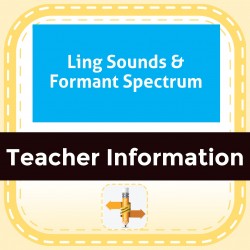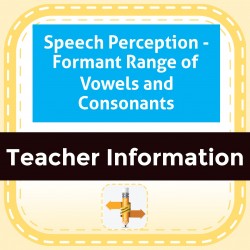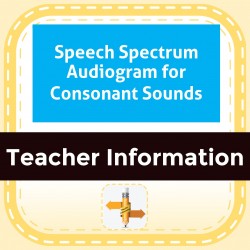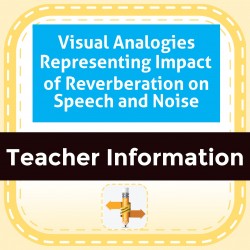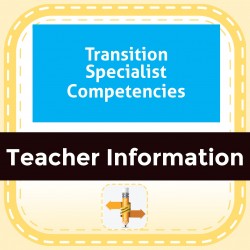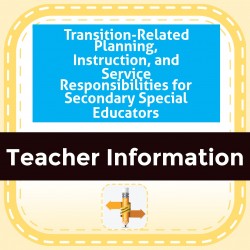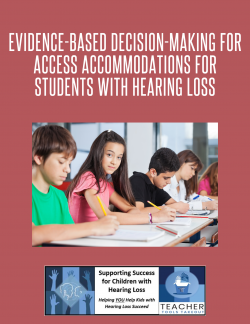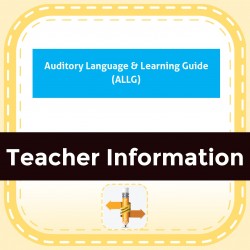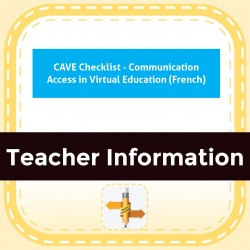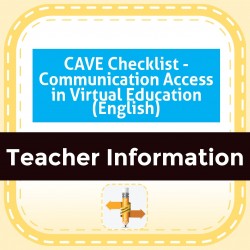Ability Levels
Categories
Resource Types
Age/Grade Range
CCSS
Anchor Standard
Speaking & Listening
Language
Reading
Ling Sounds & Formant Spectrum
$ 0
Charts showing the speECH- frequencies of each of the Ling sounds as they fit into the 1st - 4th formants. It also has a chart that shows the the speECH- frequencies of each Ling sound, 125 Hz - 6000
...
Hz.
Speech Perception - Formant Range of Vowels and Consonants
$ 0
Charts showing the speECH- frequencies of each of the vowels and consonants as they fit into the 1st - 4th formants.
Speech Spectrum Audiogram for Consonant Sounds
$ 0
SpeECH- sounds occur across frequency ranges and are usually not restricted to one audiometric frequency. An audiogram shows the spread of frequency range for consonants. This page also includes a lis
...
t of consonants, their presence at each frequency and relative loudness.
Visual Analogies Representing Impact of Reverberation on Speech and Noise
$ 0
This handout shows 3 popular analogies showing the impact of understanding written sentences in the presence of reverberation and noise and presents speECH- understanding in terms of puzzle pieces. C
...
an also be used as teaching tools to increase student understanding of reverberation and noise effects.
Transition Specialist Competencies
$ 0
This fact sheet summarizes the competencies for Transition Specialists beyond those of novice special educators. Specifies basic foundations, characteristics of learners, assessment, instructional con
...
tent, planning, managing behavior, etc.
Transition-Related Planning, Instruction, and Service Responsibilities for Secondary Special Educators
$ 0
This fact sheet summarizes the planning, instruction and service responsibilities for transition for secondary special educators. Specifies student-focused planning, student development, interagency
...
collboration, family involvement, and program structures and policies.
Evidence-Based Decision-Making for Access Accommodations for Students with Hearing Loss
$ 0
This informational handout describes the requirements of Title II of the ADA to ensure communication is as effective for students with hearing loss as it is for peers and how that relates to the need
...
for evidence-based decision-making for access accommodations required for each individual student's school situation. Includes a worksheet for discussion of student situational communication access needs.
Auditory Language & Learning Guide (ALLG)
$ 10
The Auditory Language & Learning Guide is an EXCELLENT informal evaluation tool for listening and language that can be used with students of any age and language ability. The 2 page checklist format e
...
asily allows the teacher to develop IEP goals based on identified student weaknesses in the 4 areas of audition/listening, receptive language, expressive language, and social communication. Skills can be rated as 'targeted', 'emerging', 'mastered' or 'previously assessed' and checked off by date achieved. This assessment tool can be used from year to year allowing instructors and parents to see growth in a students language and learning.
CAVE Checklist - Communication Access in Virtual Education (French)
$ 0
The CAVE Checklist in French is a self-report checklist is intended to be completed students age 9 and above who are deaf or hard of hearing to identify possible communication access issues that may o
...
ccur during virtual education situations. It is recommended that the CAVE be completed in an interview format with the DHH specialist discussing each situation with the student. Students read 10 questions related to accessing communication in online learning situations and rate them from Always Easy to Always Difficult, or Doesn't Happen. A total score can be obtained. Not every situation will apply to every student. Situations indicating appropriate access will receive scores of 4 or 5. Items scoring 1, 2, 3, need to be addressed for appropriate access needs. The 10 questions are followed by a list in which the student identifies what he or she thinks helps most during online learning.
CAVE Checklist - Communication Access in Virtual Education (English)
$ 0
The CAVE Checklist is a self-report checklist is intended to be completed students age 9 and above who are deaf or hard of hearing to identify possible communication access issues that may occur durin
...
g virtual education situations. It is recommended that the CAVE be completed in an interview format with the DHH specialist discussing each situation with the student. Students read 10 questions related to accessing communication in online learning situations and rate them from Always Easy to Always Difficult, or Doesn't Happen. A total score can be obtained. Not every situation will apply to every student. Situations indicating appropriate access will receive scores of 4 or 5. Items scoring 1, 2, 3, need to be addressed for appropriate access needs. The 10 questions are followed by a list in which the student identifies what he or she thinks helps most during online learning.
 Your browser is out of date. For best experience switch to latest updated Browser.
Your browser is out of date. For best experience switch to latest updated Browser.
 Get Chrome
Get Chrome Get Edge
Get Edge Get Firefox
Get Firefox